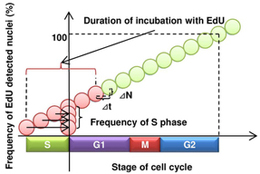Research Abstract
根の分裂組織領域と伸長領域との境界:核内倍加が急速な細胞体積増大に先行する
The boundary of the meristematic and elongation zones in roots: endoreduplication precedes rapid cell expansion
2013年10月14日 Scientific Reports 3 : 2723 doi: 10.1038/srep02723

植物の根は有糸分裂細胞の分裂組織領域および急速に膨張する細胞の伸長領域によって構成されている。伸長領域では細胞分裂を行わずにDNAが複製されていることが多く、その過程は核内倍加として知られている。5-エチニル-2′-デオキシウリジン(EdU)の取り込みによって測定される細胞周期およびDNA複製の時間は、この2つの領域の間で異なっていた(分裂組織領域では17時間、伸長領域では30時間)。EdUシグナルの核内パターンには一様および斑点状の2種類があり、それぞれS期の前期および後期の核であることを示していた。分裂組織領域と伸長領域との境界部分に関して、DNA複製のパターンと光学的に推定した個々の核のDNA量(C値)を組み合わせて解析を行った。その結果、EdUシグナルパターンが一様な4C核を持つ境界細胞が発見された。境界部分の細胞を分析することにより、根では核内倍加が急速な細胞伸長に先行することが明らかにされた。
林 耕磨1, 長谷川 淳子1 & 松永 幸大1
- 東京理科大学理工学部応用生物科学科
Plant roots consist of a meristematic zone of mitotic cells and an elongation zone of rapidly expanding cells, in which DNA replication often occurs without cell division, a process known as endoreduplication. The duration of the cell cycle and DNA replication, as measured by 5-ethynyl-2′-deoxy-uridine (EdU) incorporation, differed between the two regions (17 h in the meristematic zone, 30 h in the elongation zone). Two distinct subnuclear patterns of EdU signals, whole and speckled, marked nuclei undergoing DNA replication at early and late S phase, respectively. The boundary region between the meristematic and elongation zones was analysed by a combination of DNA replication imaging and optical estimation of the amount of DNA in each nucleus (C-value). We found a boundary cell with 4C nuclei exhibiting the whole pattern of EdU signals. Analyses of cells in the boundary region revealed that endoreduplication precedes rapid cell elongation in roots.

